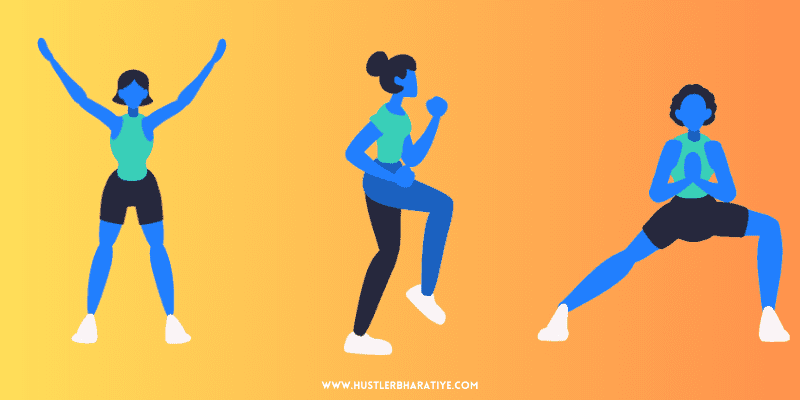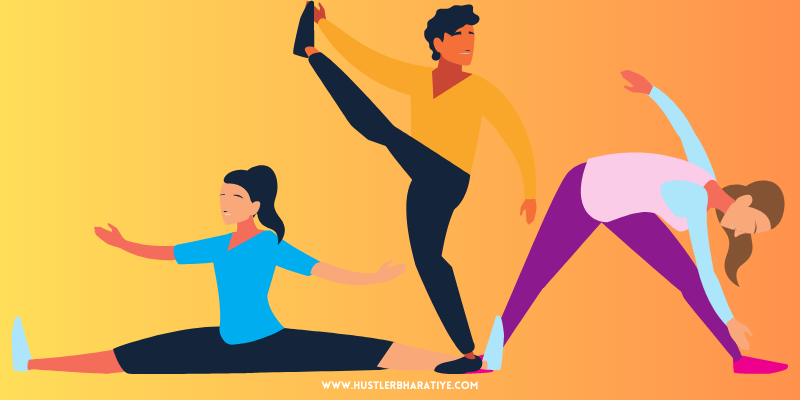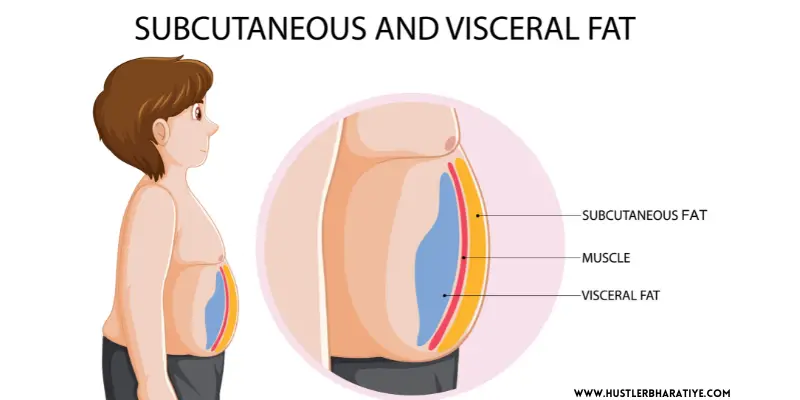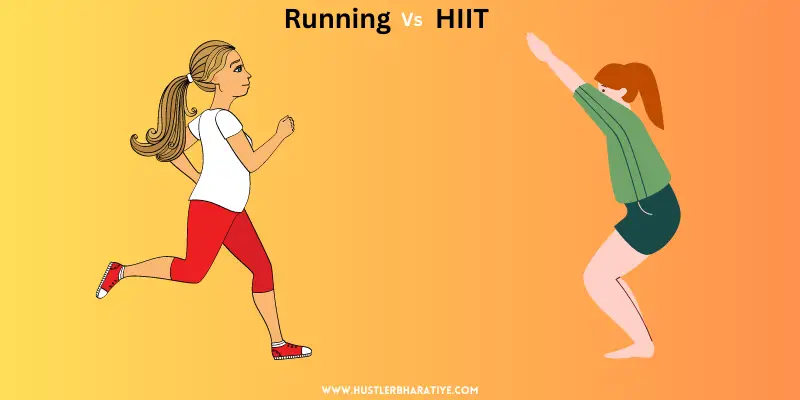Hiit for weight loss! looking for an effective way to shed pounds and get in shape, high-intensity interval training may be just what you need!
With HIIT, you do bursts of intense exercise followed by rest.
You can burn calories and lose weight with hiit, plus you’ll build muscle and improve cardio.
Check out this article to find out how HIIT can help you lose weight.
What is HIIT?

A form of exercise that involves short periods of high-intensity exercise followed by periods of rest or low-intensity activity.
High-intensity intervals push your body to its limits, and recovery periods let it rest.
This pattern of exertion and recovery can be repeated several times in a single workout session, typically lasting between 10 and 30 minutes.
As compared with steady-state cardio, HIIT is more challenging and intense, so you burn more calories faster.
Running, cycling, rowing, or bodyweight exercises like squats and burpees can all be used for HIIT.
How does HIIT work for weight loss?
HIIT can help you lose weight in several ways.
First, because HIIT is an intense form of exercise, it burns a lot of calories in a short amount of time.
Second, it can help increase your metabolism, which means you’ll continue to burn calories even after your workout is over.
This phenomenon is known as the “afterburn effect,” which is the increased calorie burn that occurs after intense exercise.
By encouraging fat loss and lowering the risk of type 2 diabetes, this exercise is useful.
Finally, this can help preserve muscle mass while burning fat, which is important for maintaining healthy body composition.
Types of HIIT workouts for weight loss

There are several types of HIIT workouts that you can perform to help you lose weight. Some popular options include:
- Tabata: A Tabata workout involves eight rounds of 20 seconds of work and 10 seconds of rest, with each round lasting four minutes.
- Circuit training: Circuit training involves performing a series of exercises in a specific order, with little to no rest between exercises.
- High-intensity cardio: High-intensity cardio involves performing cardio exercises like running, cycling, or jumping jacks at a high intensity for short intervals, followed by periods of rest.
- Other variations of HIIT: There are many other variations of HIIT, such as EMOM (Every Minute On the Minute) or AMRAP (As Many Rounds As Possible), that you can incorporate into your workout routine.
Hiit For Fat Loss And Muscle Growth
High-intensity interval training is a popular workout style that has gained popularity in recent years.
Cardiovascular exercise HIIT involves high-intensity bursts followed by resting or low-intensity periods.
HIIT is an effective way to burn fat and build muscle at the same time.
When it comes to fat loss, HIIT is an effective way to burn calories during and after your workout.
The intense nature of HIIT causes your body to continue burning calories for several hours after you finish your workout.
There’s something called the afterburn effect, or excess post-exercise oxygen consumption (EPOC).
Resistance training is necessary for muscle growth, and this workout is good for building muscle.
To optimize hiit for both fat loss and muscle growth, it’s important to include a variety of exercises that target different muscle groups.
This can include exercises like burpees, squat jumps, and push-ups. Incorporating weights, such as dumbbells or kettlebells, can also help to build muscle while performing HIIT.
Can You Lose Belly Fat With Hiit

Yes, hiit can help you lose belly fat.
In fact, it’s one of the most effective workouts for targeting belly fat.
Known as visceral fat, belly fat accumulates around your internal organs and can be dangerous.
A study found that hiit reduced abdominal fat better than steady state.
As it targets subcutaneous and visceral fat, it’s perfect for losing belly fat.
Subcutaneous fat is the fat that sits just below your skin and is more visible.
Visceral fat, on the other hand, is around your organs and increases your heart disease risk.
If you want to lose belly fat with hiit, you’ve got to do exercises that involve your core, like planks and mountain climbers.
For belly fat loss, try high-intensity interval training including jump squats and box jumps.
Is Hiit Better For Weight Loss
When it comes to losing weight, hiit is great, but is it better? depends on your goals!
It’s a form of cardiovascular exercise that can burn a significant number of calories in a short amount of time.
As a result, it’s effective for losing weight and improving your overall health.
Unlike steady-state cardio, which involves exercising longer at the same intensity.
Due to their fast burning, they can help you lose a few additional pounds.
The afterburn effect of hiit causes your body to keep burning calories for hours after your workout.
However, it's important to note that any form of exercise can be effective for weight loss as long as it creates a calorie deficit. In other words, you're burning more calories than you're taking in. Ultimately, the best workout for weight loss is the one that you enjoy and can stick to consistently.
How Much Hiit For Weight Loss
The amount of HIIT you should do for weight loss depends on your fitness level and goals.
For best results, do hiit 4-5 times per week.
You should do HIIT workouts for anywhere between 20-30 minutes, including warm-up and cool-down.
It’s important to note that HIIT can be intense, and it’s important to listen to your body and not overdo it.
Start with shorter workout intervals and gradually increase intensity and duration.
Running or HIIT for Weight Loss

Both HIIT and running can aid in weight loss, but which is best for you will depend on your objectives.
Running is a steady-state cardio exercise that involves maintaining a consistent pace for a prolonged period.
It is an excellent way to build endurance and burn calories.
Depending on the intensity, running can burn anywhere from 400 to 1000 calories per hour.
Additionally, running strengthens your glutes, hamstrings, quadriceps, and calves.
A high-intensity interval training program alternates periods of high effort with periods of rest.
You can do high-intensity interval workouts in 20 minutes and burn more calories than you would running.
As an added bonus, they boost your metabolism, meaning you burn more calories even after you finish your workout.
So, which is better for weight loss: running or HIIT?
The answer is both. Running can be an effective way to lose weight and improve cardiovascular health, while HIIT is a more time-efficient way to burn calories and boost metabolism.
HIIT or Walking for Weight Loss
Walking is easy and low-impact exercise that’s good for your health.
It is an excellent choice for people who are new to exercise or have joint problems.
It may not be enough to lose weight just by walking.
A hiit workout is short and intense.
It is a great way to boost metabolism, burn calories, and build muscle.
High-intensity interval training usually involves jumping jacks, high knees, and burpees.
While walking is a great way to get moving and improve overall health, HIIT is more effective for weight loss. By pushing the body to its limits, HIIT workouts can burn more calories and increase metabolism more effectively than walking alone.
Jogging or HIIT for Weight Loss
Jogging is a steady-state cardio exercise that involves maintaining a consistent pace for a prolonged period.
It builds endurance and burns calories.
Depending on the intensity, jogging can burn anywhere from 400 to 1000 calories per hour.
An intense form of exercise, HIIT, can be completed in a shorter time period.
It is a great way to boost metabolism, burn calories, and build muscle.
What’s better for weight loss: jogging or HIIT?
The answer is both. Jogging is an effective way to burn calories and build endurance, while HIIT is a more time-efficient way to burn calories and boost metabolism. Incorporating both into a fitness routine can lead to maximum weight loss and overall health benefits.
Hiit For Weight Loss Beginners
If you’re new to HIIT, it’s important to start slow and build up gradually.
Given how demanding and stressful HIIT may be on the body, it’s critical to give yourself time to acclimate.
Beginner HIIT workouts should be shorter in duration, around 10-15 minutes, and with longer rest periods.
Maintain proper form and technique to avoid injuries
Here’s an example beginner HIIT workout:
- Warm-up: 5 minutes of light cardio (such as walking or cycling)
- Work phase: 20 seconds of jumping jacks rest for 40 seconds
- Work phase: 20 seconds of bodyweight squats, rest for 40 seconds
- Work phase: 20 seconds of mountain climbers rest for 40 seconds
- Work phase: 20 seconds of push-ups rest for 40 seconds
- Repeat the above sequence for 2-3 rounds
- Cool down: 5 minutes of stretching
Hiit Weight Loss Exercises
The best activities for weight loss that may be integrated into HIIT sessions are:
- Burpees: This full-body exercise works multiple muscle groups and elevates the heart rate.
- Jump squats: This explosive exercise targets the lower body and increases calorie burn.
- High knees: This exercise elevates the heart rate while targeting the core and lower body.
- Jump lunges: This exercise combines cardio and strength training, targeting the legs and glutes.
- Mountain climbers: This exercise is a great cardio and core workout that targets the entire body.
What Are the Best HIIT Exercises for Weight Loss
The best HIIT exercises for weight loss are those that are intense, full-body, and require a lot of energy.
Some of the best exercises for HIIT include:
Burpees
A burpee combines a squat, plank, and jump into one exercise.
How to do:-
Start in a standing position, drop into a squat, jump back into a plank, do a push-up, jump back to the squat, and finish with a jump. Repeat this sequence for the recommended amount of time or repetitions.
Jump squats
Jump squats are a plyometric exercise that targets the lower body.
How to do:-
Start in a squat position, jump explosively as high as you can, and land softly in the squat position. Repeat this sequence for the recommended amount of time or repetitions.
High knees
High knees are a cardio exercise that targets the lower body and core.
How to do:-
Stand with your feet hip-width apart, and start running in place, bringing your knees up as high as possible, alternating between legs. Repeat this sequence for the recommended amount of time or repetitions.
Jump lunges
Jump lunges are a plyometric exercise that targets the lower body.
How to do:-
Start in a lunge position with your left leg forward, jump explosively, and switch your legs mid-air, landing with your right leg forward. Repeat this sequence for the recommended amount of time or repetitions.
Mountain climbers
Mountain climbers are a cardio exercise that targets the core and upper body.
How to do:-
Start in a plank position, bring your left knee up to your chest, return to the starting position, and repeat with your right knee. Continue alternating between legs for the recommended amount of time or repetitions.
Box jumps
Box jumps are a plyometric exercise that targets the lower body.
How to do:-
Stand in front of a sturdy box, jump explosively onto the box, and step down. Repeat this sequence for the recommended amount of time or repetitions.
Kettlebell swings
Kettlebell swings are a full-body exercise that targets the core and lower body.
How to do:-
Holding a kettlebell in both hands, stand with your feet shoulder-width apart. Swing the kettlebell between your legs, then press your hips forward and swing it up to shoulder height. Repeat this sequence for the recommended amount of time or repetitions.
Battle ropes
Battle ropes are a full-body exercise that targets the upper body and core.
How to do:-
Start by standing with your feet shoulder-width apart, holding one end of a rope in each hand, and move your arms up and down in a wave-like motion, as fast as you can. Repeat this sequence for the recommended amount of time or repetitions.
Rowing machine sprints
Rowing machine sprints are full-body exercise that targets the upper body and core.
How to do:-
Sit on a rowing machine, grasp the handles, and row as fast as you can for the recommended amount of time or distance.
Cycling sprints
Cycling sprints are a cardio exercise that targets the lower body.
How to do:-
Start cycling on a stationary bike, and pedal as fast as you can for the recommended amount of time or distance.
HIIT vs Weight Training for Fat Loss
Both HIIT and weight training can be effective for fat loss, but they work in different ways.
Weight training builds muscle mass and boosts metabolism, while HIIT workouts burn calories and cardio.
While HIIT workouts burn more calories during the workout, weight training increases metabolism and burns more calories at rest.
Therefore, a combination of both HIIT and weight training can be an effective approach to fat loss.
HIIT Workout Plan for Weight Loss at Home
These workouts can easily be done at home with little to no equipment required.
Here’s a sample hiit workout plan for weight loss that you can try at home:
Warm-up:
- 5 minutes of dynamic stretching (arm circles, leg swings, etc.)
Workout:
- 30 seconds of high knees
- 30 seconds of rest
- 30 seconds of mountain climbers
- 30 seconds of rest
- 30 seconds of jumping jacks
- 30 seconds of rest
- 30 seconds of squat jumps
- 30 seconds of rest
- 30 seconds of burpees
- 30 seconds of rest
- 30 seconds of jumping lunges
- 30 seconds of rest
- Repeat the circuit 3-4 times
Cool-down:
- 5-10 minutes of static stretching (hamstring stretch, quad stretch, etc.)
This HIIT workout plan can be modified to fit your fitness level and preferences by adjusting the exercise duration or rest time. It's important to listen to your body and not push yourself too hard, especially if you're new to HIIT workouts.
Benefits of HIIT for Weight Loss
HIIT workouts have numerous benefits for weight loss, including:
- Increased calorie burn: HIIT workouts can burn more calories in a shorter amount of time compared to steady-state exercises like jogging.
- Improved cardiovascular health: By increasing your heart rate and oxygen consumption, HIIT workouts are good for your heart.
- Boosted metabolism: HIIT workouts can increase metabolism for up to 48 hours after exercise, which means more calories are burned at rest.
- Muscle growth: HIIT workouts can provide an anaerobic workout that promotes muscle growth and development.
- Time-efficient: HIIT workouts can be completed in as little as 20-30 minutes, making them a great option for those with busy schedules.
Overall, HIIT is an effective and efficient way to lose weight and build muscle. It can be easily incorporated into a fitness routine and modified to fit individual fitness levels and preferences.
How Much Weight Can You Lose in a Month with HIIT
This workout will help you shed a few pounds, depending on your starting weight, body composition, diet, and exercise.
With the right approach, you can see significant weight loss results in a month with HIIT.
On average, it’s recommended to aim for a weight loss of 1-2 pounds per week, which translates to 4-8 pounds in a month. Due to the high-intensity nature of HIIT, you might lose more weight. Some studies suggest that people can lose up to 5 pounds or more in a month with regular HIIT workouts.
Keep in mind that weight loss isn’t just about shedding pounds on the scale.
HIIT can also help you lose body fat, gain muscle, and improve your overall health and fitness.
Additionally, the more weight you have to lose, the faster you may see results in the beginning.
It's essential to approach weight loss with a healthy and sustainable mindset, rather than trying to achieve quick and drastic results. Consistency is key, and incorporating HIIT into your overall fitness routine, along with a balanced diet, can lead to long-term weight loss success.
How to create a HIIT workout for weight loss
Creating a HIIT workout for weight loss is simple. Here’s how to do it:
- Determine your target heart rate: To get the most out of your HIIT workout, it’s important to work at a high intensity. To do this, you’ll need to determine your target heart rate, which is 80% to 95% of your maximum heart rate.
- Structure your workout: Once you’ve determined your target heart rate, you can structure your workout by selecting exercises and intervals that will help you reach and maintain that heart rate.
- Adjust for your fitness level: Finally, it’s important to adjust your workout for your fitness level. If you’re new to exercise, start with shorter intervals and adjust the intensity as needed. As you become fitter, you can gradually increase the duration and intensity of your intervals.
Tips for getting the most out of your HIIT workout
To get the most out of your HIIT workout and maximize your weight loss efforts, consider these tips:
- Warm-up and cool down properly: Before starting your HIIT workout, take the time to warm up properly. This can help prevent injury and prepare your body for the intense exercise to come. Similarly, it’s important to cool down after your workout to help your body recover.
- Prevent injury: HIIT is an intense form of exercise, so it’s important to take steps to prevent injury. This includes using proper form during exercises, wearing appropriate shoes and clothing, and listening to your body, and avoiding exercises that cause pain.
- Track your progress: To see the results of your HIIT workouts, it’s important to track your progress. This can include monitoring your weight, body measurements, and fitness level. You can also keep a workout log to track your intervals and exercise choices.
FAQs
1.How many times per week should I do HIIT for weight loss?
It’s recommended to do HIIT workouts 2-3 times per week for weight loss. This allows your body to recover between workouts and helps prevent injury.
2.How long should a HIIT workout be?
A typical HIIT workout can be done in as little as 10-20 minutes. However, the length of the workout can vary depending on your fitness level and the specific exercises you choose to do.
3.Can I do HIIT workouts at home?
Yes! HIIT workouts can be done at home with little to no equipment. There are many free resources available online that offer HIIT workout videos and routines.
4.What are some good exercises for a HIIT workout?
Good exercises for a HIIT workout include burpees, jump squats, mountain climbers, and high knees. However, there are many other exercises you can choose from depending on your preferences and fitness level.
5.How long will it take to see results from HIIT for weight loss?
Results from HIIT for weight loss can vary depending on many factors, including your starting weight, fitness level, and diet. However, with consistency and effort, you can start to see results in as little as a few weeks.
6.Can HIIT be done by beginners?
Yes, HIIT can be done by beginners! However, it’s important to start slowly and gradually increase the intensity and duration of your workouts over time.
7. Is HIIT safe for individuals with medical conditions?
HIIT may not be safe for individuals with certain medical conditions or injuries. It’s always best to consult with your healthcare provider before starting any new exercise program, including HIIT.
8.Will HIIT alone help me lose weight?
While HIIT can be a great way to burn calories and lose weight, it’s important to also focus on maintaining a healthy diet and lifestyle habits for optimal weight loss results.
Final thoughts
HIIT for weight loss is a great way to get in shape.
By incorporating short bursts of intense exercise into your workout routine, you can burn more calories and increase your metabolism.
There are many types of HIIT workouts to choose from, and creating a workout for weight loss is simple.
You can successfully lose weight with HIIT if you follow these tips and track your progress.
It is an effective way to burn calories, increase metabolism, and lose weight.
Plan and create your own HIIT workout that suits your fitness level and preferences.
Why don’t you give it a try and see how it works?
Cheers!
